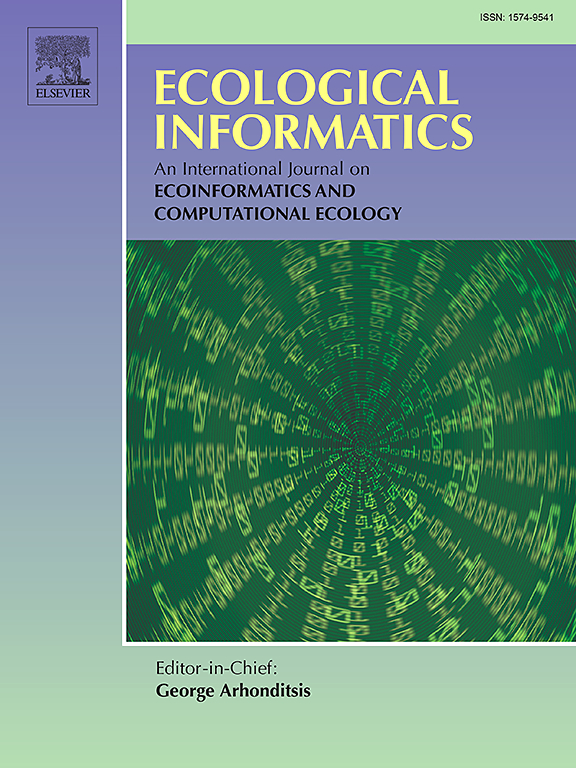植物物种竞争的理论模型:以入侵的Carpobrotus sp. pl.和地中海沿岸本地物种为例
IF 5.8
2区 环境科学与生态学
Q1 ECOLOGY
引用次数: 0
摘要
本文介绍并研究了一个新的数学模型,该模型描述了入侵植物和本地植物在资源和空间竞争中的相互作用。第一类以Carpobrotus sp. pl.为代表,第二类以沿海地区原生种为代表。根据建模中使用的术语,我们使用术语“种群”来指代植物的集合,即本地和外来入侵。与经典的Lotka-Volterra竞争模型不同,这里我们假设入侵物种遵循广义logistic增长规律,而本地种群则遵循logistic增长规律。此外,在竞争术语中,我们考虑到两个植物种群在3D空间中相互作用,并且相互作用发生在植被斑块和/或体积的边界上,这意味着两个密度也将由两个指数来表征。通过对该模型的一些特殊情况的研究,对该模型进行了完整的数学分析。该模型的特点是存在不同的平衡点,如两个种群都灭绝的平凡平衡点、无carpobrotus平衡、无原生植物平衡和共存平衡。计算模拟结果表明存在不同的双稳态情况,并对上述三种平衡的三稳定性进行了研究。研究结果表明,人为干预导致Carpobrotus初始种群数量减少和(或)本地种群数量增加的外部因素可能有助于无Carpobrotus平衡或共存平衡的稳定。本文章由计算机程序翻译,如有差异,请以英文原文为准。
A theoretical model of plant species competition: The case of invasive Carpobrotus sp. pl. and native Mediterranean coastal species
In this paper we introduce and study a new mathematical model that describes the interaction between invasive and native plants in competition for resources and space. The first are represented by Carpobrotus sp. pl. while the second by the native coastal area species. Following the terminology used in modeling, we have used the term “population” to refer to the set of plants, i.e. native and alien invasive. Differently than in a classical Lotka–Volterra competition model, here we assume that the invasive species grow following a generalized logistic growth law while the native population a logistic one. Moreover, in the competition term we take into account the fact that the two populations of plant interact in a 3D space and the interaction occurs on the borders of the vegetation patch and/or volume, meaning that both densities will be characterized also by two exponents. A complete mathematical analysis of the proposed model was done by studying also some particular cases of it. The model is characterized by the presence of different equilibrium points such as the trivial equilibrium point, where both populations get extinct, the Carpobrotus-free equilibrium, the native-plant-free equilibrium and the coexistence, where both plant populations coexists. Computational simulations show that different bistability scenarios exist but also the tristability of the last three equilibrium introduced above was studied. The obtained results suggest that external factors, due to human intervention, that leads to a decrease in the initial population of Carpobrotus sp. pl. and/or increase of the native population might help in having the stability of the Carpobrotus-free equilibrium or the coexistence equilibrium.
求助全文
通过发布文献求助,成功后即可免费获取论文全文。
去求助
来源期刊

Ecological Informatics
环境科学-生态学
CiteScore
8.30
自引率
11.80%
发文量
346
审稿时长
46 days
期刊介绍:
The journal Ecological Informatics is devoted to the publication of high quality, peer-reviewed articles on all aspects of computational ecology, data science and biogeography. The scope of the journal takes into account the data-intensive nature of ecology, the growing capacity of information technology to access, harness and leverage complex data as well as the critical need for informing sustainable management in view of global environmental and climate change.
The nature of the journal is interdisciplinary at the crossover between ecology and informatics. It focuses on novel concepts and techniques for image- and genome-based monitoring and interpretation, sensor- and multimedia-based data acquisition, internet-based data archiving and sharing, data assimilation, modelling and prediction of ecological data.
 求助内容:
求助内容: 应助结果提醒方式:
应助结果提醒方式:


